University HRM 5: Case Incident - Shared Leadership Implementation
VerifiedAdded on 2022/08/21
|6
|913
|22
Report
AI Summary
This report analyzes a case incident focused on shared leadership within an organizational context. It begins by identifying potential obstacles to implementing a shared leadership approach, such as the cultivation of self-awareness, lack of shared commitment, and absence of a working relationship. The report then proposes solutions to overcome these challenges, emphasizing the importance of clearly defined roles and collaborative efforts. The second part of the report explores the implementation of a shared leadership initiative, suggesting elements of job design and redesign, including task identification, employee motivation, reward systems, and resource allocation. Finally, the report contrasts shared leadership with traditional leadership approaches, highlighting instances where the latter may be preferable, such as in situations demanding a clear hierarchical structure and decisive action. The report also discusses situational and individual factors that contribute to the effectiveness of traditional leadership.

Running head: HRM
Case Incident- Sharing is performing
Name of the Student:
Name of the University:
Author Note:
Case Incident- Sharing is performing
Name of the Student:
Name of the University:
Author Note:
Paraphrase This Document
Need a fresh take? Get an instant paraphrase of this document with our AI Paraphraser
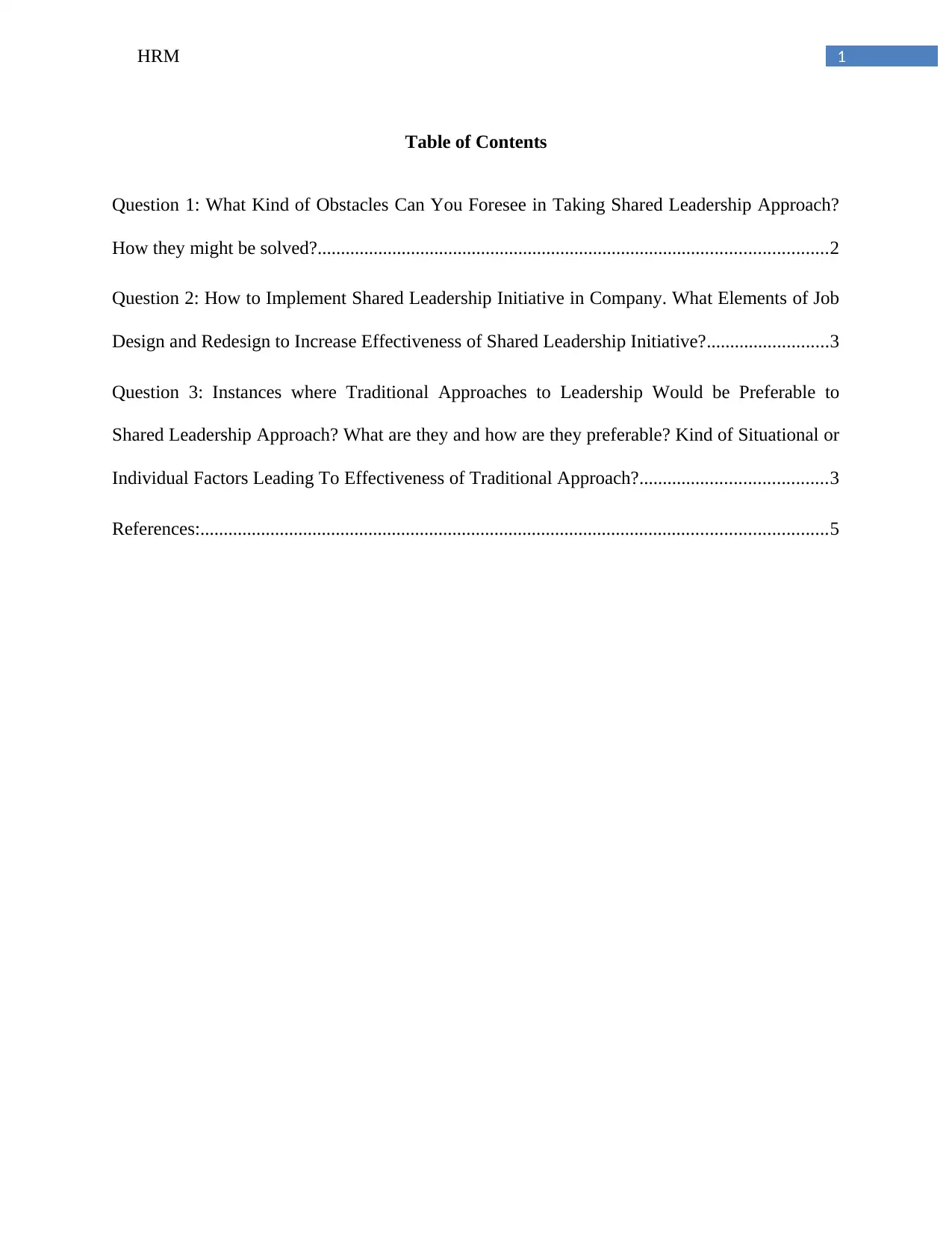
1HRM
Table of Contents
Question 1: What Kind of Obstacles Can You Foresee in Taking Shared Leadership Approach?
How they might be solved?.............................................................................................................2
Question 2: How to Implement Shared Leadership Initiative in Company. What Elements of Job
Design and Redesign to Increase Effectiveness of Shared Leadership Initiative?..........................3
Question 3: Instances where Traditional Approaches to Leadership Would be Preferable to
Shared Leadership Approach? What are they and how are they preferable? Kind of Situational or
Individual Factors Leading To Effectiveness of Traditional Approach?........................................3
References:......................................................................................................................................5
Table of Contents
Question 1: What Kind of Obstacles Can You Foresee in Taking Shared Leadership Approach?
How they might be solved?.............................................................................................................2
Question 2: How to Implement Shared Leadership Initiative in Company. What Elements of Job
Design and Redesign to Increase Effectiveness of Shared Leadership Initiative?..........................3
Question 3: Instances where Traditional Approaches to Leadership Would be Preferable to
Shared Leadership Approach? What are they and how are they preferable? Kind of Situational or
Individual Factors Leading To Effectiveness of Traditional Approach?........................................3
References:......................................................................................................................................5
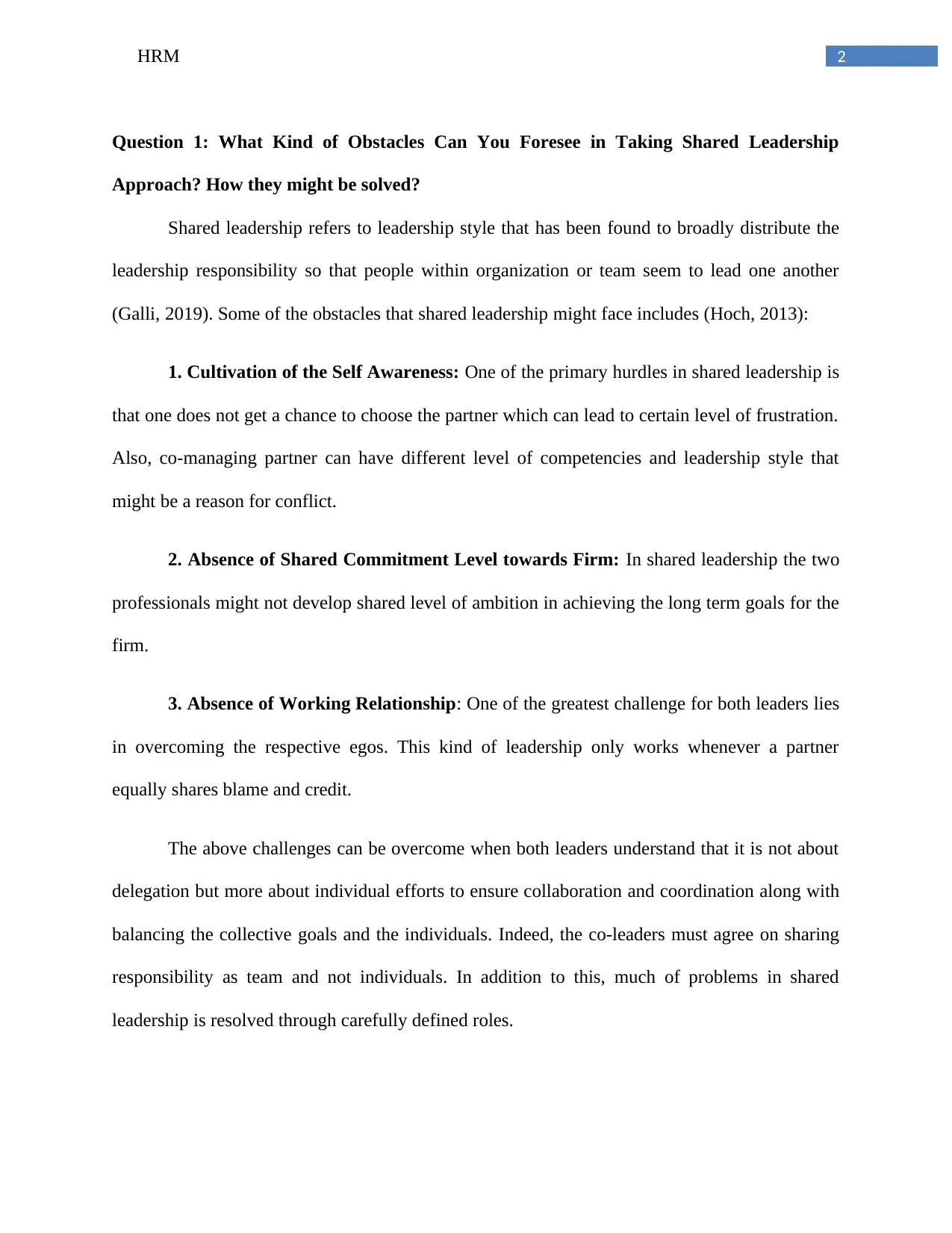
2HRM
Question 1: What Kind of Obstacles Can You Foresee in Taking Shared Leadership
Approach? How they might be solved?
Shared leadership refers to leadership style that has been found to broadly distribute the
leadership responsibility so that people within organization or team seem to lead one another
(Galli, 2019). Some of the obstacles that shared leadership might face includes (Hoch, 2013):
1. Cultivation of the Self Awareness: One of the primary hurdles in shared leadership is
that one does not get a chance to choose the partner which can lead to certain level of frustration.
Also, co-managing partner can have different level of competencies and leadership style that
might be a reason for conflict.
2. Absence of Shared Commitment Level towards Firm: In shared leadership the two
professionals might not develop shared level of ambition in achieving the long term goals for the
firm.
3. Absence of Working Relationship: One of the greatest challenge for both leaders lies
in overcoming the respective egos. This kind of leadership only works whenever a partner
equally shares blame and credit.
The above challenges can be overcome when both leaders understand that it is not about
delegation but more about individual efforts to ensure collaboration and coordination along with
balancing the collective goals and the individuals. Indeed, the co-leaders must agree on sharing
responsibility as team and not individuals. In addition to this, much of problems in shared
leadership is resolved through carefully defined roles.
Question 1: What Kind of Obstacles Can You Foresee in Taking Shared Leadership
Approach? How they might be solved?
Shared leadership refers to leadership style that has been found to broadly distribute the
leadership responsibility so that people within organization or team seem to lead one another
(Galli, 2019). Some of the obstacles that shared leadership might face includes (Hoch, 2013):
1. Cultivation of the Self Awareness: One of the primary hurdles in shared leadership is
that one does not get a chance to choose the partner which can lead to certain level of frustration.
Also, co-managing partner can have different level of competencies and leadership style that
might be a reason for conflict.
2. Absence of Shared Commitment Level towards Firm: In shared leadership the two
professionals might not develop shared level of ambition in achieving the long term goals for the
firm.
3. Absence of Working Relationship: One of the greatest challenge for both leaders lies
in overcoming the respective egos. This kind of leadership only works whenever a partner
equally shares blame and credit.
The above challenges can be overcome when both leaders understand that it is not about
delegation but more about individual efforts to ensure collaboration and coordination along with
balancing the collective goals and the individuals. Indeed, the co-leaders must agree on sharing
responsibility as team and not individuals. In addition to this, much of problems in shared
leadership is resolved through carefully defined roles.
⊘ This is a preview!⊘
Do you want full access?
Subscribe today to unlock all pages.

Trusted by 1+ million students worldwide
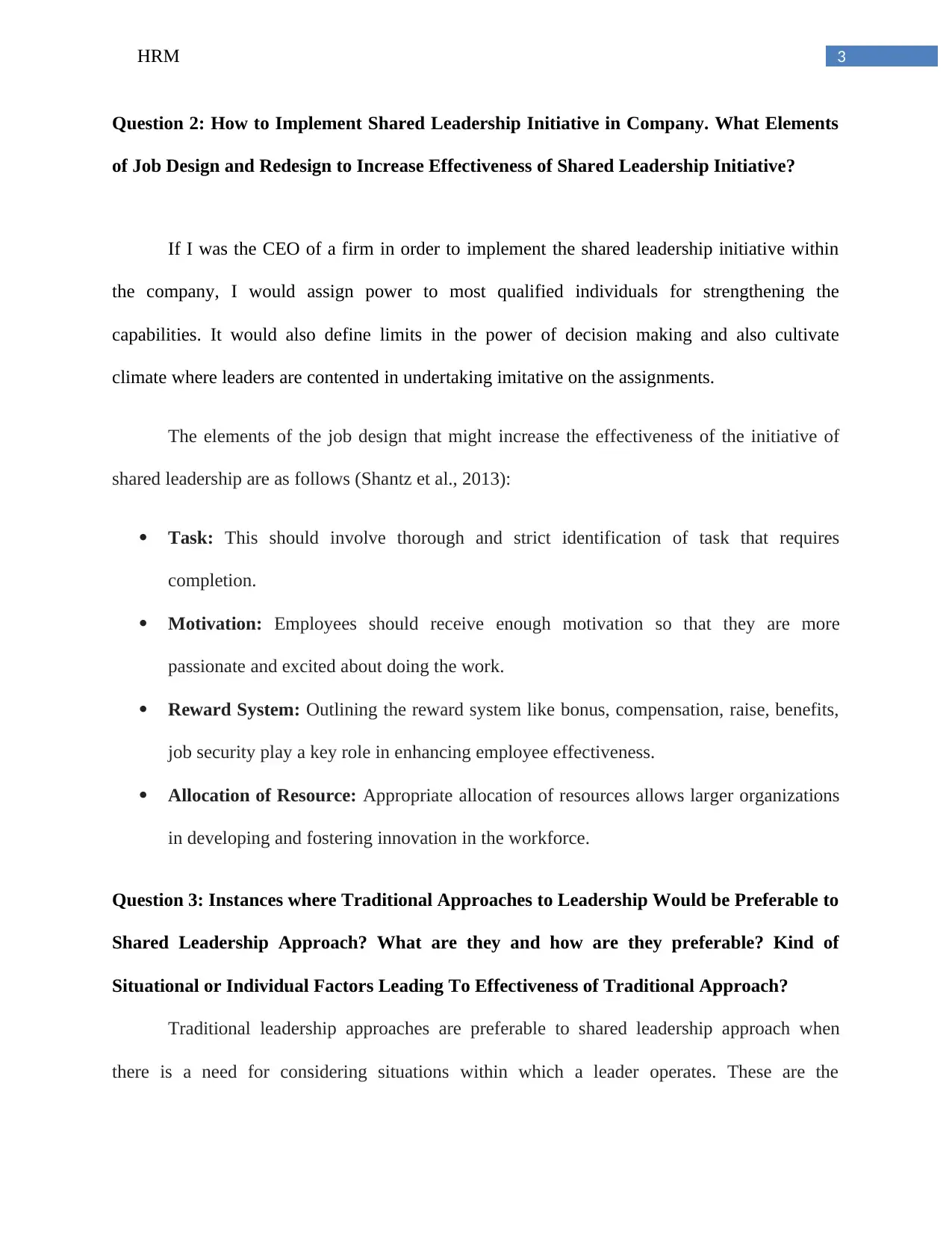
3HRM
Question 2: How to Implement Shared Leadership Initiative in Company. What Elements
of Job Design and Redesign to Increase Effectiveness of Shared Leadership Initiative?
If I was the CEO of a firm in order to implement the shared leadership initiative within
the company, I would assign power to most qualified individuals for strengthening the
capabilities. It would also define limits in the power of decision making and also cultivate
climate where leaders are contented in undertaking imitative on the assignments.
The elements of the job design that might increase the effectiveness of the initiative of
shared leadership are as follows (Shantz et al., 2013):
Task: This should involve thorough and strict identification of task that requires
completion.
Motivation: Employees should receive enough motivation so that they are more
passionate and excited about doing the work.
Reward System: Outlining the reward system like bonus, compensation, raise, benefits,
job security play a key role in enhancing employee effectiveness.
Allocation of Resource: Appropriate allocation of resources allows larger organizations
in developing and fostering innovation in the workforce.
Question 3: Instances where Traditional Approaches to Leadership Would be Preferable to
Shared Leadership Approach? What are they and how are they preferable? Kind of
Situational or Individual Factors Leading To Effectiveness of Traditional Approach?
Traditional leadership approaches are preferable to shared leadership approach when
there is a need for considering situations within which a leader operates. These are the
Question 2: How to Implement Shared Leadership Initiative in Company. What Elements
of Job Design and Redesign to Increase Effectiveness of Shared Leadership Initiative?
If I was the CEO of a firm in order to implement the shared leadership initiative within
the company, I would assign power to most qualified individuals for strengthening the
capabilities. It would also define limits in the power of decision making and also cultivate
climate where leaders are contented in undertaking imitative on the assignments.
The elements of the job design that might increase the effectiveness of the initiative of
shared leadership are as follows (Shantz et al., 2013):
Task: This should involve thorough and strict identification of task that requires
completion.
Motivation: Employees should receive enough motivation so that they are more
passionate and excited about doing the work.
Reward System: Outlining the reward system like bonus, compensation, raise, benefits,
job security play a key role in enhancing employee effectiveness.
Allocation of Resource: Appropriate allocation of resources allows larger organizations
in developing and fostering innovation in the workforce.
Question 3: Instances where Traditional Approaches to Leadership Would be Preferable to
Shared Leadership Approach? What are they and how are they preferable? Kind of
Situational or Individual Factors Leading To Effectiveness of Traditional Approach?
Traditional leadership approaches are preferable to shared leadership approach when
there is a need for considering situations within which a leader operates. These are the
Paraphrase This Document
Need a fresh take? Get an instant paraphrase of this document with our AI Paraphraser
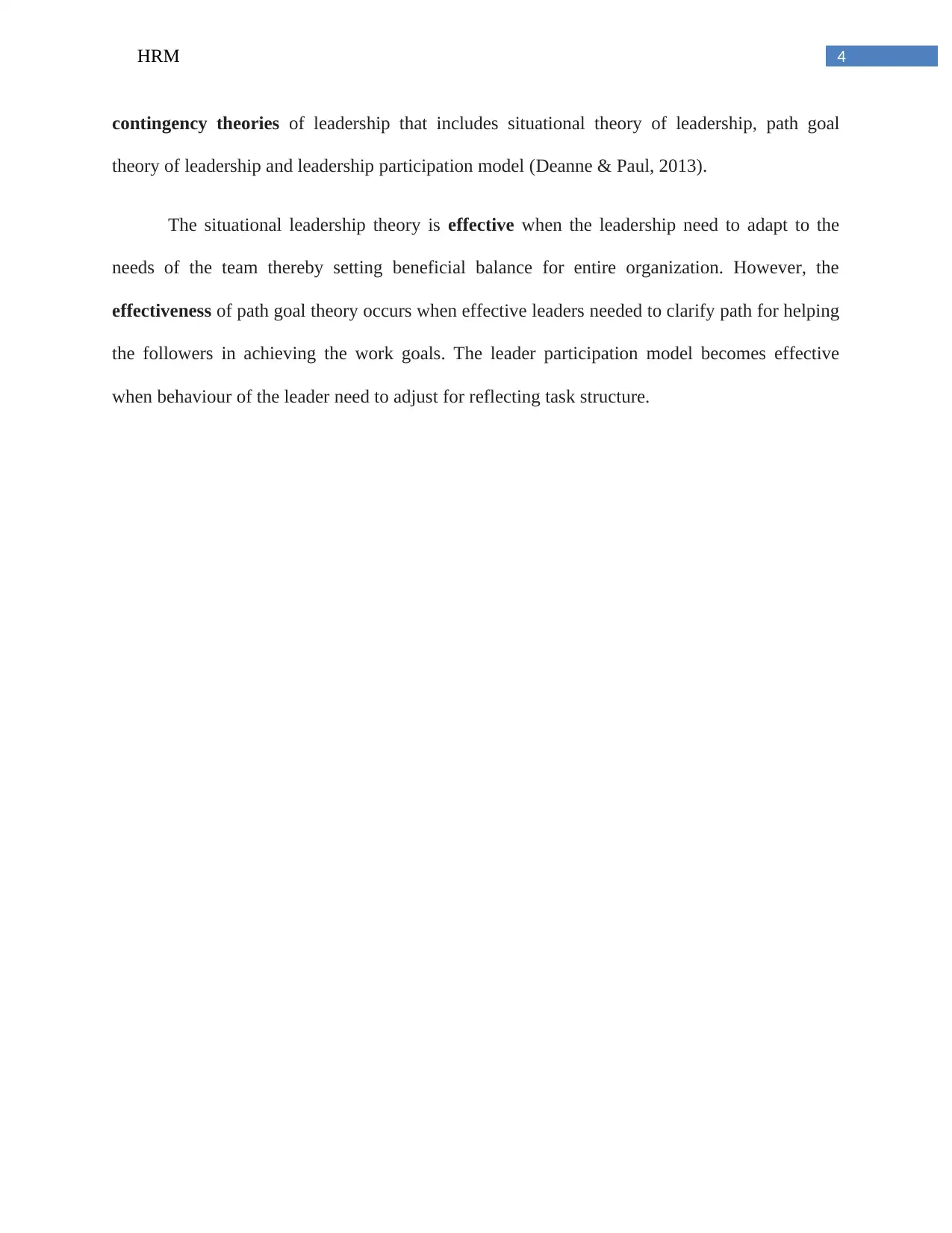
4HRM
contingency theories of leadership that includes situational theory of leadership, path goal
theory of leadership and leadership participation model (Deanne & Paul, 2013).
The situational leadership theory is effective when the leadership need to adapt to the
needs of the team thereby setting beneficial balance for entire organization. However, the
effectiveness of path goal theory occurs when effective leaders needed to clarify path for helping
the followers in achieving the work goals. The leader participation model becomes effective
when behaviour of the leader need to adjust for reflecting task structure.
contingency theories of leadership that includes situational theory of leadership, path goal
theory of leadership and leadership participation model (Deanne & Paul, 2013).
The situational leadership theory is effective when the leadership need to adapt to the
needs of the team thereby setting beneficial balance for entire organization. However, the
effectiveness of path goal theory occurs when effective leaders needed to clarify path for helping
the followers in achieving the work goals. The leader participation model becomes effective
when behaviour of the leader need to adjust for reflecting task structure.
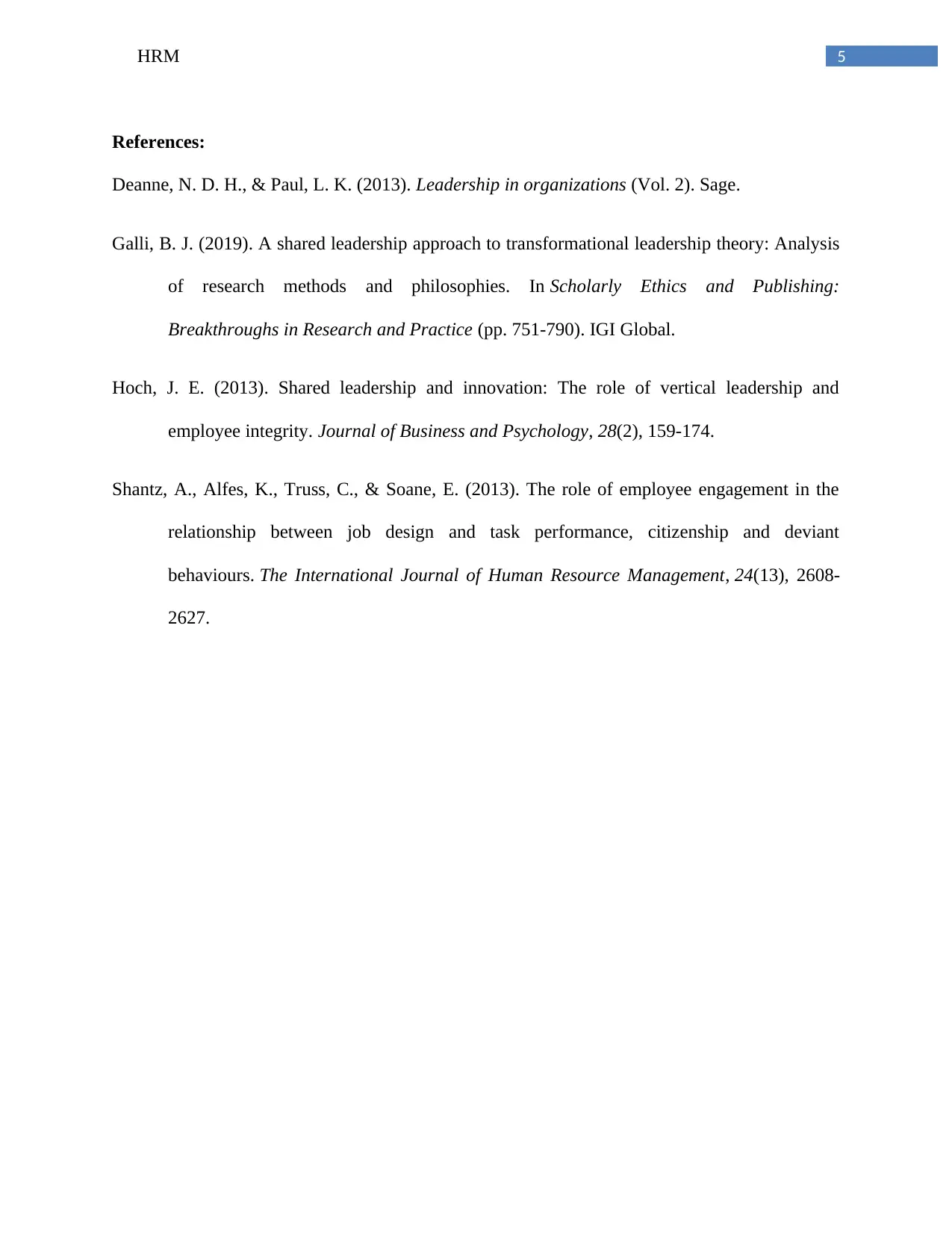
5HRM
References:
Deanne, N. D. H., & Paul, L. K. (2013). Leadership in organizations (Vol. 2). Sage.
Galli, B. J. (2019). A shared leadership approach to transformational leadership theory: Analysis
of research methods and philosophies. In Scholarly Ethics and Publishing:
Breakthroughs in Research and Practice (pp. 751-790). IGI Global.
Hoch, J. E. (2013). Shared leadership and innovation: The role of vertical leadership and
employee integrity. Journal of Business and Psychology, 28(2), 159-174.
Shantz, A., Alfes, K., Truss, C., & Soane, E. (2013). The role of employee engagement in the
relationship between job design and task performance, citizenship and deviant
behaviours. The International Journal of Human Resource Management, 24(13), 2608-
2627.
References:
Deanne, N. D. H., & Paul, L. K. (2013). Leadership in organizations (Vol. 2). Sage.
Galli, B. J. (2019). A shared leadership approach to transformational leadership theory: Analysis
of research methods and philosophies. In Scholarly Ethics and Publishing:
Breakthroughs in Research and Practice (pp. 751-790). IGI Global.
Hoch, J. E. (2013). Shared leadership and innovation: The role of vertical leadership and
employee integrity. Journal of Business and Psychology, 28(2), 159-174.
Shantz, A., Alfes, K., Truss, C., & Soane, E. (2013). The role of employee engagement in the
relationship between job design and task performance, citizenship and deviant
behaviours. The International Journal of Human Resource Management, 24(13), 2608-
2627.
⊘ This is a preview!⊘
Do you want full access?
Subscribe today to unlock all pages.

Trusted by 1+ million students worldwide
1 out of 6
Related Documents
Your All-in-One AI-Powered Toolkit for Academic Success.
+13062052269
info@desklib.com
Available 24*7 on WhatsApp / Email
![[object Object]](/_next/static/media/star-bottom.7253800d.svg)
Unlock your academic potential
Copyright © 2020–2025 A2Z Services. All Rights Reserved. Developed and managed by ZUCOL.





